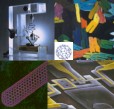Quantum Vista of Computing
In standard textbooks, after Deutsch-Jozsa comes quantum Fourier transform that is followed by Shor's quantum prime decomposition algorithm. We shall not cover these subject here, primarily because their demand of mathematical skills which might be too much for your usual cats, quantum or otherwise. There might be later additions on this subject, and also on Grover's quantum search algorithm.
We shall therefore part with technical subject here, and ponder on the current and future of the quantum information in relation to the so-called real world which is synonymous to the commercial world.
 |
The way the computer power increases is well captured by the "Moor's Law", that states, if I remember corectly, computer chips gets ten times faster in three years. This has come from both faster clock speed and also from superior and efficient design using the finer scale chip manufacturing. As for the clock speed, current speed around 2 GHz is already hitting the limit in terms of heat generation. |
As for the miniaturization, the current state of the art semiconducter utilizes 100 nm curcuit. This means that we are in fact already close to the quantum domain. Usual computer chips expresses "0" and "1" by macroscopic current involving billion electrons. The current has to be reduced in smaller cuircuit design. If we want to keep up with the Moor's Law for another 30 yeras, we necessarily have to reduce the size of the cuicuit to 10 nm range and the number of involved electrons to thousands, hundreds, tens and eventually to a few. This naturally leads to quantum computer.
Therefore, just to keep the business alive with incremental improvements, computer compony has to design the chips that operate in quantum scale. And if that is achieved, as we have learnt in this eNote, we shall probably be able to implement quantum computing algorithms in semiconductors, and achieve something far, far beyond the continuation of Moor's projection. Enlarging the repartoire of quantum algorithm and establishing generic algorithm, therefore, is more than just the matter of academic interest.
|
